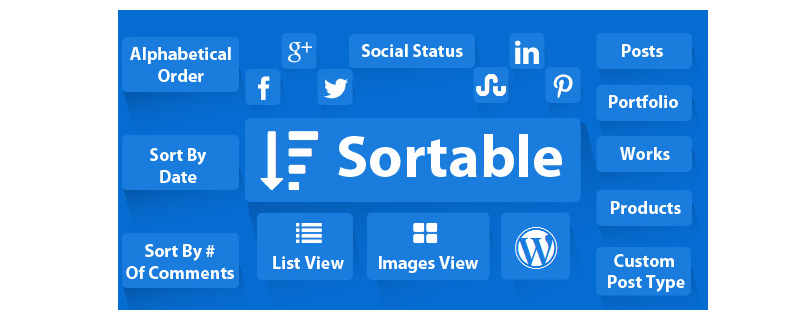 Web Front-end
Web Front-end
 JS Tutorial
JS Tutorial
 How to achieve the effect of mouse reordering elements through the sortable method
How to achieve the effect of mouse reordering elements through the sortable method
How to achieve the effect of mouse reordering elements through the sortable method
The sortable method in the jQuery UI plug-in can use the mouse to rearrange elements in a list or grid. It can specify the element style during element rearrangement or return the id value of the sortable element. Array
jQuery UI includes many widgets that maintain state, so whether you are creating a highly interactive web application or adding a date picker control to your page, jQuery UI is a perfect choice. And all jQuery UI widgets use the same pattern, so just learn one and the others will follow. Today we are going to introduce a powerful plug-in in jQuery UI, its function is mainly used for sorting. Next, I will introduce it to you in detail in the article, I hope it will be helpful to you.

【Recommended course: jQuery UI Tutorial】
jQueryUI provides the sortable() method, which allows you to reorder elements in a list or grid using the mouse.
It is used in two forms:
$(selector,context).sortable(options)方法
$(selector,context).sortable(“action”,[params])方法
$(selector, context).sortable(options) method
Indicates that the declared HTML element contains Interchangeable components. The option parameter is an object that specifies the behavior of the elements involved during reordering
Example: Use placeholders
Set a blank placeholder when the sorting action occurs CSS style
External introduction of jQuery UI plug-in
<link href = "https://code.jquery.com/ui/1.10.4/themes/ui-lightness/jquery-ui.css"rel = "stylesheet"> <script src = "https://code.jquery.com/jquery-1.10.2.js"></script> <script src = "https://code.jquery.com/ui/1.10.4/jquery-ui.js"></script>
Code:
#sortable { list-style-type: none; margin: 0;
padding: 0; width:360px; }
#sortable li { margin: 0 3px 3px 3px; padding: 0.4em;
padding-left: 1.5em; font-size: 17px; height: 16px; }
.highlight {
border: 1px solid #333;
font-weight: bold;
font-size: 45px;
background-color: #ccc;
}
.default {
background: #b7ecf3;
border: 1px solid #DDDDDD;
color: #444;
}
</style>
<script>
$(function() {
$( "#sortable" ).sortable({
placeholder: "highlight"
});
});
</script>The rendering is as follows:

$(selector, context).sortable("action", [params]) method
You can perform actions on sortable elements, for example, to prevent displacement. The operation is specified as a string in the first parameter, and optionally, one or more parameters can be provided based on the given operation.
Basically, the actions here are nothing but jQuery methods and we can use them in the form of strings
Example: Using toArray() method
This method returns an array of id values of sortable elements in sorted order. This method takes Options as a parameter to customize the serialization or sorting order
<style>
#sortable{ list-style-type: none; margin: 0;
padding: 0; width:300px; float:left;}
#sortable li{ margin: 0 3px 3px 3px; padding: 0.4em;
padding-left: 1.5em; font-size: 17px; height: 16px; }
.default {
background:#b7ecf3;
border: 1px solid #DDDDDD;
color: #333333;
}
</style>
<script>
$(function() {
$('#sortable').sortable({
update: function(event, ui) {
var productOrder = $(this).sortable('toArray').toString();
$("#sortable-1").text (productOrder);
}
});
});
</script>Rendering:

Summary: The above is the entire content of this article , I hope that through this article, everyone can understand the use of jQuery UI
The above is the detailed content of How to achieve the effect of mouse reordering elements through the sortable method. For more information, please follow other related articles on the PHP Chinese website!

Hot AI Tools

Undresser.AI Undress
AI-powered app for creating realistic nude photos

AI Clothes Remover
Online AI tool for removing clothes from photos.

Undress AI Tool
Undress images for free

Clothoff.io
AI clothes remover

Video Face Swap
Swap faces in any video effortlessly with our completely free AI face swap tool!

Hot Article

Hot Tools

Notepad++7.3.1
Easy-to-use and free code editor

SublimeText3 Chinese version
Chinese version, very easy to use

Zend Studio 13.0.1
Powerful PHP integrated development environment

Dreamweaver CS6
Visual web development tools

SublimeText3 Mac version
God-level code editing software (SublimeText3)

Hot Topics
 1657
1657
 14
14
 1415
1415
 52
52
 1309
1309
 25
25
 1257
1257
 29
29
 1229
1229
 24
24
 Demystifying JavaScript: What It Does and Why It Matters
Apr 09, 2025 am 12:07 AM
Demystifying JavaScript: What It Does and Why It Matters
Apr 09, 2025 am 12:07 AM
JavaScript is the cornerstone of modern web development, and its main functions include event-driven programming, dynamic content generation and asynchronous programming. 1) Event-driven programming allows web pages to change dynamically according to user operations. 2) Dynamic content generation allows page content to be adjusted according to conditions. 3) Asynchronous programming ensures that the user interface is not blocked. JavaScript is widely used in web interaction, single-page application and server-side development, greatly improving the flexibility of user experience and cross-platform development.
 The Evolution of JavaScript: Current Trends and Future Prospects
Apr 10, 2025 am 09:33 AM
The Evolution of JavaScript: Current Trends and Future Prospects
Apr 10, 2025 am 09:33 AM
The latest trends in JavaScript include the rise of TypeScript, the popularity of modern frameworks and libraries, and the application of WebAssembly. Future prospects cover more powerful type systems, the development of server-side JavaScript, the expansion of artificial intelligence and machine learning, and the potential of IoT and edge computing.
 JavaScript Engines: Comparing Implementations
Apr 13, 2025 am 12:05 AM
JavaScript Engines: Comparing Implementations
Apr 13, 2025 am 12:05 AM
Different JavaScript engines have different effects when parsing and executing JavaScript code, because the implementation principles and optimization strategies of each engine differ. 1. Lexical analysis: convert source code into lexical unit. 2. Grammar analysis: Generate an abstract syntax tree. 3. Optimization and compilation: Generate machine code through the JIT compiler. 4. Execute: Run the machine code. V8 engine optimizes through instant compilation and hidden class, SpiderMonkey uses a type inference system, resulting in different performance performance on the same code.
 JavaScript: Exploring the Versatility of a Web Language
Apr 11, 2025 am 12:01 AM
JavaScript: Exploring the Versatility of a Web Language
Apr 11, 2025 am 12:01 AM
JavaScript is the core language of modern web development and is widely used for its diversity and flexibility. 1) Front-end development: build dynamic web pages and single-page applications through DOM operations and modern frameworks (such as React, Vue.js, Angular). 2) Server-side development: Node.js uses a non-blocking I/O model to handle high concurrency and real-time applications. 3) Mobile and desktop application development: cross-platform development is realized through ReactNative and Electron to improve development efficiency.
 Python vs. JavaScript: The Learning Curve and Ease of Use
Apr 16, 2025 am 12:12 AM
Python vs. JavaScript: The Learning Curve and Ease of Use
Apr 16, 2025 am 12:12 AM
Python is more suitable for beginners, with a smooth learning curve and concise syntax; JavaScript is suitable for front-end development, with a steep learning curve and flexible syntax. 1. Python syntax is intuitive and suitable for data science and back-end development. 2. JavaScript is flexible and widely used in front-end and server-side programming.
 How to Build a Multi-Tenant SaaS Application with Next.js (Frontend Integration)
Apr 11, 2025 am 08:22 AM
How to Build a Multi-Tenant SaaS Application with Next.js (Frontend Integration)
Apr 11, 2025 am 08:22 AM
This article demonstrates frontend integration with a backend secured by Permit, building a functional EdTech SaaS application using Next.js. The frontend fetches user permissions to control UI visibility and ensures API requests adhere to role-base
 From C/C to JavaScript: How It All Works
Apr 14, 2025 am 12:05 AM
From C/C to JavaScript: How It All Works
Apr 14, 2025 am 12:05 AM
The shift from C/C to JavaScript requires adapting to dynamic typing, garbage collection and asynchronous programming. 1) C/C is a statically typed language that requires manual memory management, while JavaScript is dynamically typed and garbage collection is automatically processed. 2) C/C needs to be compiled into machine code, while JavaScript is an interpreted language. 3) JavaScript introduces concepts such as closures, prototype chains and Promise, which enhances flexibility and asynchronous programming capabilities.
 How do I install JavaScript?
Apr 05, 2025 am 12:16 AM
How do I install JavaScript?
Apr 05, 2025 am 12:16 AM
JavaScript does not require installation because it is already built into modern browsers. You just need a text editor and a browser to get started. 1) In the browser environment, run it by embedding the HTML file through tags. 2) In the Node.js environment, after downloading and installing Node.js, run the JavaScript file through the command line.



